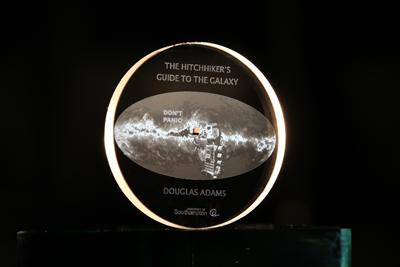The Hitchhiker’s Guide to the Galaxy ‘5D Crystal’ at the British Library

On Sunday 08 March 2020, a copy of Douglas Adams’s The Hitchhiker’s Guide to the Galaxy, stored on a crystal using advanced technology, will be presented to the Curators of the British Library at a special 42nd Anniversary of The Hitchhiker’s Guide event in London. It will become the first book in this new format at the National Collection.
‘5D Memory Crystal’ technology was developed by Professor Peter Kazansky’s research team at the University of Southampton’s Optoelectronics Research Centre in an attempt to upgrade our ability to store information intact for longer, improving resilience to the range of hazards and extreme environmental conditions to which data storage formats can be exposed through time.
The need to store information without loss matters to all of us, both to the individual and, at a communal scale, for the continued preservation of the cultural and scientific achievements of the human species. When looking into the popular formats for storing information, each comes with its vulnerabilities: Paper is susceptible to many forms of damage and micro-electronic storage is vulnerable to magnetism and loss when copied repeatedly from legacy to newer formats.
The crystal is a physical three-dimensional silica-based object, inside which data is written by a short-pulse laser into high density planes at various inclinations. The data can then survive, without any loss, unusual levels of temperature, magnetism and cosmic radiation.
The technological progress this research achieved exceeded expectations, to the point where, in 2014, the Guinness Book of Records recognised the material as “The most durable digital storage medium, stable at room temperature for 300 quintillion years”, which means it can be expected to endure beyond a realistic survival expectancy of our species. Its resilience to the conditions found outside our atmosphere was the reason the ‘eternity crystal’ format was selected by Space-X to be sent into heliocentric orbit in 2018.
Explaining the practical value of his research at the University of Southampton Professor Kazansky said “With this technology, potentially no empirical information, no knowledge, no world literature need ever be lost by the human race again.”
As researchers continue to invest, modify and improve the system, data can now be written to this format faster than ever before. A modification provisionally named by the team as ‘Type X’ has recently been applied and this, as Prof. Kazansky explains, inscribes “into high density oblate spheroid-shaped nanovoids with different shapes and inclinations.” 250 such oriented layers of micro-storage has been trialled in the laboratory versions of the ‘eternity crystal’, but in this version data has been recorded across a symbolic 42 layers.
The Hitchhiker’s Guide was considered the most naturally appropriate title to commemorate not only because of the number of layers used in this version but also because of Douglas Adams’ fascination with science and technology. Prof Kazansky added, “Science fiction has a predictive quality, which is sometimes fulfilled much later by advances in research and discovery. With respect for Douglas Adams’ realisation in the book of accessing knowledge on the internet through a browser on a hand-held device, written in 1978, it is with pleasure that science can now in some small way repay our literary heritage by presenting a format in which novels can be preserved for an indefinite period of time.”
Professor Kazansky’s team are grateful to Pan Macmillan publishers for granting their permission to reproduce and store this novel in a new format.
More information on the British Library's "The Hitchhikers Guide to the Galaxy at 42" event is available here.

As a background for the Hitchhikers Guide to the Galaxy crystal, Professor Kazansky used the real image of interstellar dust that fills our Milky Way Galaxy, reconstructed by ESA’s Gaia satellite , placing the Hitchhikers Guide to the Galaxy in the middle of our galaxy!